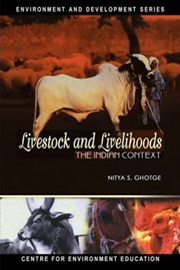Book contents
- Frontmatter
- Foreword
- Acknowledgements
- Contents
- Preface
- Chapter 1 The Beginning …
- Chapter 2 Patterns of Livestock rearing
- Chapter 3 Traditional Practices in Animal Rearing
- Chapter 4 Emerging Trends in Livestock Rearing
- Chapter 5 It must not End: Towards an Alternative Policy
- Chapter 6 Reorienting Ourselves
- Chapter 7 Framework for An Alternate Policy
- References
- Index
Chapter 2 - Patterns of Livestock rearing
Published online by Cambridge University Press: 26 October 2011
- Frontmatter
- Foreword
- Acknowledgements
- Contents
- Preface
- Chapter 1 The Beginning …
- Chapter 2 Patterns of Livestock rearing
- Chapter 3 Traditional Practices in Animal Rearing
- Chapter 4 Emerging Trends in Livestock Rearing
- Chapter 5 It must not End: Towards an Alternative Policy
- Chapter 6 Reorienting Ourselves
- Chapter 7 Framework for An Alternate Policy
- References
- Index
Summary
India has the distinction not merely of having a rich and diverse number of animal species, but we also have the distinction of having some of the widest range of breeds within each species, thereby representing a significant percentage of the world's domesticated livestock diversity. Of the breeds found in the world, those found in India are represented below in Table 2.
This rich diversity is directly accounted for by the fact that the subcontinent itself is diverse in culture, in its agro-ecological zones, in social and economic practices. These breeds have developed and evolved over time to suit the different production goals and requirements of these different farmers.
Traditionally, livestock rearing was also distinctly related to castes and communities with specialized groups rearing distinct animal types. Even today these communities continue to rear these animals and therefore any development programme has to take into account these regional differences, preferences and choices.
Major Agro-ecological Zones in the Country and Livestock Practices within Pastoral Systems
Large tracts of the country are semi-arid or arid and frequently threatened by droughts. Sustained agriculture is impossible or extremely difficult. However, these regions border grasslands that are covered by pasture over parts of the year. These are the regions where even today, migratory or semi-migratory systems of livestock rearing continue to be practiced. The species most suitable for migrating is the sheep. Sheep live in groups and herds and are primarily grazers as far as their eating habits.
- Type
- Chapter
- Information
- Livestock and LivelihoodsThe Indian Context, pp. 7 - 34Publisher: Foundation BooksPrint publication year: 2004
- 1
- Cited by



